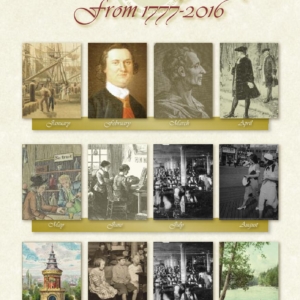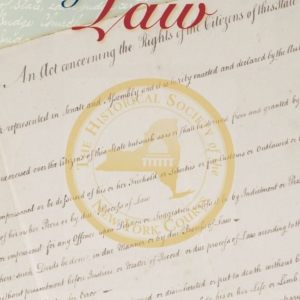Description
January 2012

Sojourner Truth: First African-American to Win a Lawsuit
SOJOURNER TRUTH (1797-1883) was an African-American abolitionist and women’s rights activist. She was born into slavery in upstate New York, and with her infant daughter escaped to freedom in 1826. New York began to legislate for abolition of slavery in 1799, adopting emancipation legislation on July 4, 1827. The law did not provide for a specific date of collective emancipation. Rather it legislated staggered dates of freedom based on age and gender on the theory that the work force should not be overburdened. Sojourner obtained her freedom on July 4, 1827. Upon learning that her five year-old son had been sold by his New York owner to an Alabama slave-holder, Sojourner commenced a lawsuit to recover him. She brought her action in the Ulster County Courthouse, and a plaque recognizing this sits on the courthouse grounds (see accompanying image). She maintained that the sale of her son to a slave state violated the provisions of New York’s emancipation law (L. 1817, ch 137) making it illegal to sell a New York slave out-of-state if such a sale denied the individual the benefits of the law. Sojourner prevailed in late 1828 and recovered her son, thereby becoming the first black woman to win a lawsuit in the United States. An interesting note to the litigation is that her lawyer, later to become Court of Appeals Judge Charles H. Ruggles (1847-1855; Chief Judge 1851-1853), helped Sojourner to regain custody of her son and charged no fee.
Images:
Sojourner Truth, Mathew Brady Studio, c. 1864. National Portrait Gallery, Smithsonian Institution, Ref. NPG.2002.90
Ulster County Courthouse, Kingston, NY. Courtesy of Ulster County Tourism
Plaque dedicated to Sojourner Truth at Ulster County Courthouse. Courtesy of Ulster County Tourism
February 2012
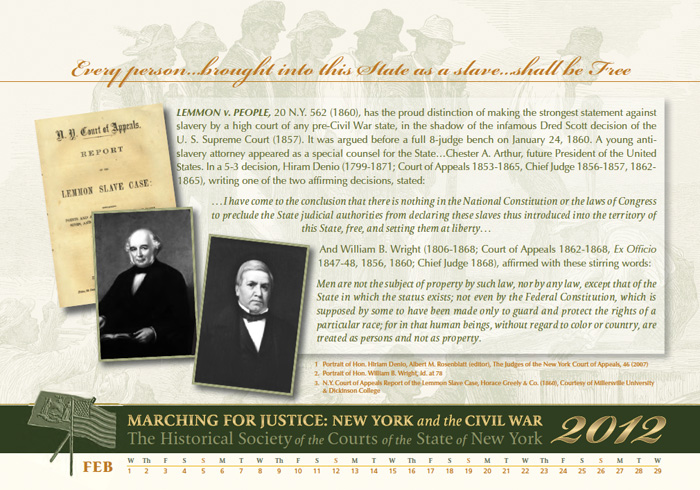
Lemmon v. People: Every Person Brought into This State as a Slave shall be Free
LEMMON V. PEOPLE, 20 N.Y. 562 (1860), has the proud distinction of making the strongest statement against slavery by a high court of any pre-Civil War state, in the shadow of the infamous Dred Scott decision of the U. S. Supreme Court (1857). It was argued before a full 8-judge bench on January 24, 1860. A young antislavery attorney appeared as a special counsel for the State Chester A. Arthur, future President of the United States. In a 5-3 decision, Hiram Denio (1799-1871; Court of Appeals 1853-1865, Chief Judge 1856-1857, 1862- 1865), writing one of the two affirming decisions, stated:
. . . I have come to the conclusion that there is nothing in the National Constitution or the laws of Congress to preclude the State judicial authorities from declaring these slaves thus introduced into the territory of this State, free, and setting them at liberty. . .
And William B. Wright (1806-1868; Court of Appeals 1862-1868, Ex Officio 1847-48, 1856, 1860; Chief Judge 1868), affirmed with these stirring words:
Men are not the subject of property by such law, nor by any law, except that of the State in which the status exists; not even by the Federal Constitution, which is supposed by some to have been made only to guard and protect the rights of a particular race; for in that human beings, without regard to color or country, are treated as persons and not as property.
Images:
Portrait of Hon. Hiriam Denio, Albert M. Rosenblatt (editor), The Judges of the New York Court of Appeals, 46 (2007)
Portrait of Hon. William B. Wright, Id. at 78
N.Y. Court of Appeals Report of the Lemmon Slave Case, Horace Greely & Co. (1860), Courtesy of Millersville University & Dickinson College
March 2012
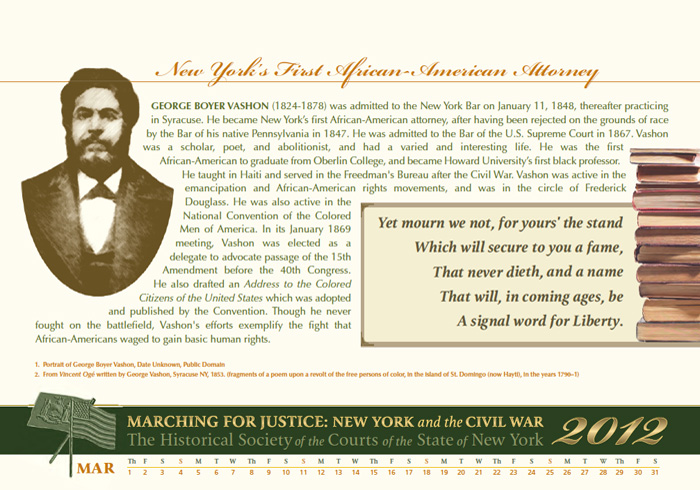
George Boyer Vashon: New York’s First African-American Attorney
GEORGE BOYER VASHON (1824-1878) was admitted to the New York Bar on January 11, 1848, thereafter practicing in Syracuse. He became New York’s first African-American attorney, after having been rejected on the grounds of race by the Bar of his native Pennsylvania in 1847. He was admitted to the Bar of the U.S. Supreme Court in 1867. Vashon was a scholar, poet, and abolitionist, and had a varied and interesting life. He was the first African-American to graduate from Oberlin College, and became Howard University’s first black professor. He taught in Haiti and served in the Freedman’s Bureau after the Civil War. Vashon was active in the emancipation and African-American rights movements, and was in the circle of Frederick Douglass. He was also active in the National Convention of the Colored Men of America. In its January 1869 meeting, Vashon was elected as a delegate to advocate passage of the 15th Amendment before the 40th Congress. He also drafted an Address to the Colored Citizens of the United States which was adopted and published by the Convention. Though he never fought on the battlefield, Vashon’s efforts exemplify the fight that African-Americans waged to gain basic human rights.
Images:
Portrait of George Boyer Vashon, Date Unknown, Public Domain
From Vincent Og written by George Vashon, Syracuse NY, 1853. (fragments of a poem upon a revolt of the free persons of color, in the island of St. Domingo (now Hayti), in the years 1790-1)
April 2012
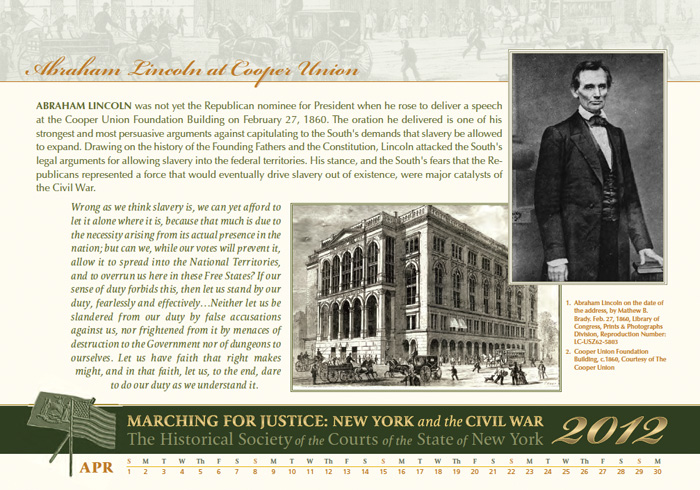
Abraham Lincoln at Cooper Union
ABRAHAM LINCOLN was not yet the Republican nominee for President when he rose to deliver a speech at the Cooper Union Foundation Building on February 27, 1860. The oration he delivered is one of his strongest and most persuasive arguments against capitulating to the South’s demands that slavery be allowed to expand. Drawing on the history of the Founding Fathers and the Constitution, Lincoln attacked the South’s legal arguments for allowing slavery into the federal territories. His stance, and the South’s fears that the Republicans represented a force that would eventually drive slavery out of existence, were major catalysts of the Civil War.
Wrong as we think slavery is, we can yet afford to let it alone where it is, because that much is due to the necessity arising from its actual presence in the nation; but can we, while our votes will prevent it, allow it to spread into the National Territories, and to overrun us here in these Free States? If our sense of duty forbids this, then let us stand by our duty, fearlessly and effectivelyÖNeither let us be slandered from our duty by false accusations against us, nor frightened from it by menaces of destruction to the Government nor of dungeons to ourselves. Let us have faith that right makes might, and in that faith, let us, to the end, dare to do our duty as we understand it.
Images:
Abraham Lincoln on the date of the address, by Mathew B. Brady. Feb. 27, 1860, Library of Congress, Prints & Photographs Division, Reproduction Number: LC-USZ62-5803
Cooper Union Foundation Building, c.1860, Courtesy of The Cooper Union
May 2012
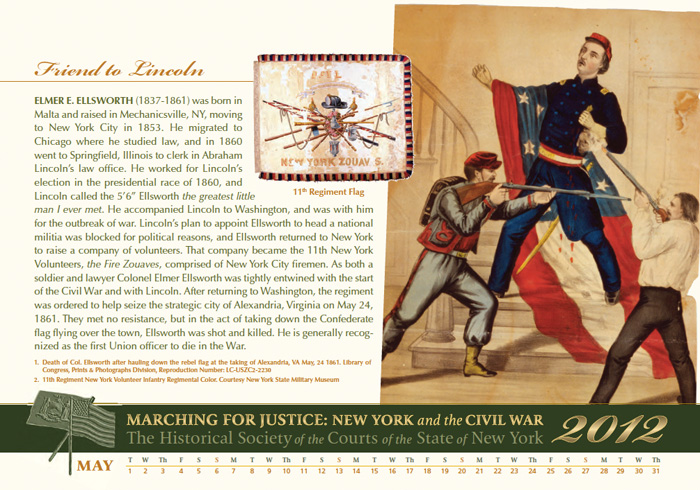
Elmer E. Ellsworth: Friend to Lincoln
ELMER E. ELLSWORTH (1837-1861) was born in Malta and raised in Mechanicsville, NY, moving to New York City in 1853. He migrated to Chicago where he studied law, and in 1860 went to Springfield, Illinois to clerk in Abraham Lincoln’s law office. He worked for Lincoln’s election in the presidential race of 1860, and Lincoln called the 5’6 in Ellsworth the greatest little man I ever met. He accompanied Lincoln to Washington, and was with him for the outbreak of war. Lincoln’s plan to appoint Ellsworth to head a national militia was blocked for political reasons, and Ellsworth returned to New York to raise a company of volunteers. That company became the 11th New York Volunteers, the Fire Zouaves, comprised of New York City firemen. As both a soldier and lawyer Colonel Elmer Ellsworth was tightly entwined with the start of the Civil War and with Lincoln. After returning to Washington, the regiment was ordered to help seize the strategic city of Alexandria, Virginia on May 24, 1861. They met no resistance, but in the act of taking down the Confederate flag flying over the town, Ellsworth was shot and killed. He is generally recognized as the first Union officer to die in the War.
Images:
Death of Col. Ellsworth after hauling down the rebel flag at the taking of Alexandria, VA May, 24 1861. Library of Congress, Prints & Photographs Division, Reproduction Number: LC-USZC2-2230
11th Regiment New York Volunteer Infantry Regimental Color. Courtesy New York State Military Museum
June 2012
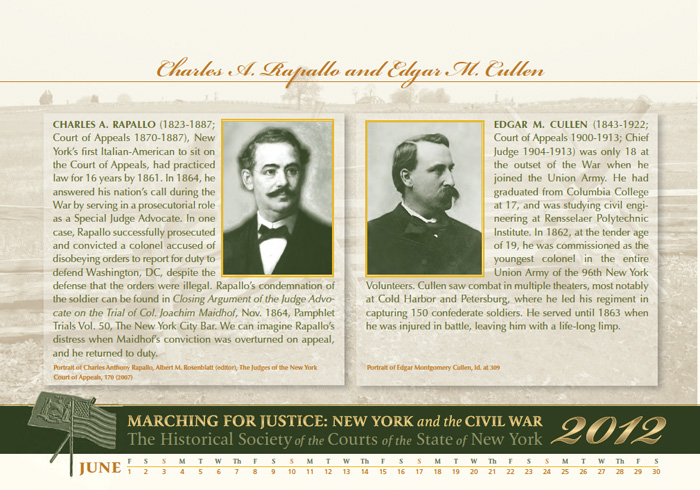
Charles A. Rapallo and Edgar M. Cullen
CHARLES A. RAPALLO (1823-1887; Court of Appeals 1870-1887), New York’s first Italian-American to sit on the Court of Appeals, had practiced law for 16 years by 1861. In 1864, he answered his nation’s call during the War by serving in a prosecutorial role as a Special Judge Advocate. In one case, Rapallo successfully prosecuted and convicted a colonel accused of disobeying orders to report for duty to defend Washington, DC, despite the defense that the orders were illegal. Rapallo’s condemnation of the soldier can be found in Closing Argument of the Judge Advocate on the Trial of Col. Joachim Maidhof, Nov. 1864, Pamphlet Trials Vol. 50, The New York City Bar. We can imagine Rapallo’s distress when Maidhof’s conviction was overturned on appeal, and he returned to duty.
EDGAR M. CULLEN (1843-1922; Court of Appeals 1900-1913; Chief Judge 1904-1913) was only 18 at the outset of the War when he joined the Union Army. He had graduated from Columbia College at 17, and was studying civil engineering at Rensselaer Polytechnic Institute. In 1862, at the tender age of 19, he was commissioned as the youngest colonel in the entire Union Army of the 96th New York Volunteers. Cullen saw combat in multiple theaters, most notably at Cold Harbor and Petersburg, where he led his regiment in capturing 150 confederate soldiers. He served until 1863 when he was injured in battle, leaving him with a life-long limp.
Images:
Portrait of Charles Anthony Rapallo, Albert M. Rosenblatt (editor), The Judges of the New York Court of Appeals, 170 (2007)
Portrait of Edgar Montgomery Cullen, Id. at 309
July 2012
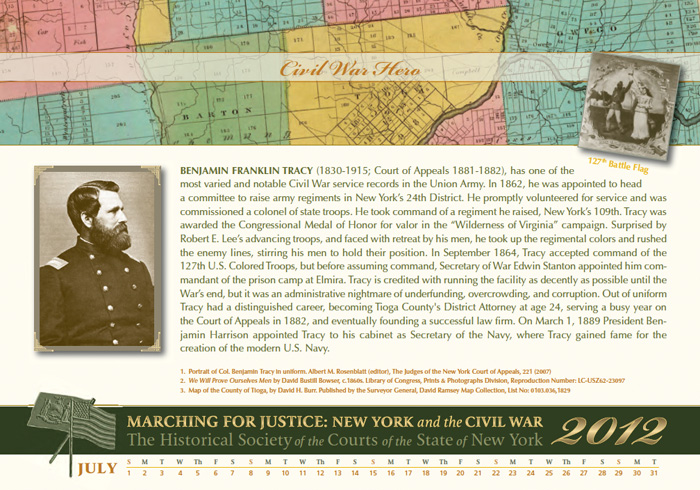
Benjamin Franklin Tracy: Civil War Hero
BENJAMIN FRANKLIN TRACY (1830-1915; Court of Appeals 1881-1882), has one of the most varied and notable Civil War service records in the Union Army. In 1862, he was appointed to head a committee to raise army regiments in New York’s 24th District. He promptly volunteered for service and was commissioned a colonel of state troops. He took command of a regiment he raised, New York’s 109th. Tracy was awarded the Congressional Medal of Honor for valor in the ‘Wilderness of Virginia’ campaign. Surprised by Robert E. Lee’s advancing troops, and faced with retreat by his men, he took up the regimental colors and rushed the enemy lines, stirring his men to hold their position. In September 1864, Tracy accepted command of the 127th U.S. Colored Troops, but before assuming command, Secretary of War Edwin Stanton appointed him commandant of the prison camp at Elmira. Tracy is credited with running the facility as decently as possible until the War”s end, but it was an administrative nightmare of underfunding, overcrowding, and corruption. Out of uniform Tracy had a distinguished career, becoming Tioga County’s District Attorney at age 24, serving a busy year on the Court of Appeals in 1882, and eventually founding a successful law firm. On March 1, 1889 President Benjamin Harrison appointed Tracy to his cabinet as Secretary of the Navy, where Tracy gained fame for the creation of the modern U.S. Navy.
Images:
Portrait of Col. Benjamin Tracy in uniform. Albert M. Rosenblatt (editor), The Judges of the New York Court of Appeals, 221 (2007)
We Will Prove Ourselves Men by David Bustill Bowser, c.1860s. Library of Congress, Prints & Photographs Division, Reproduction Number: LC-USZ62-230973
Map of the County of Tioga, by David H. Burr. Published by the Surveyor General, David Ramsey Map Collection, List No: 0103.036,1829
August 2012
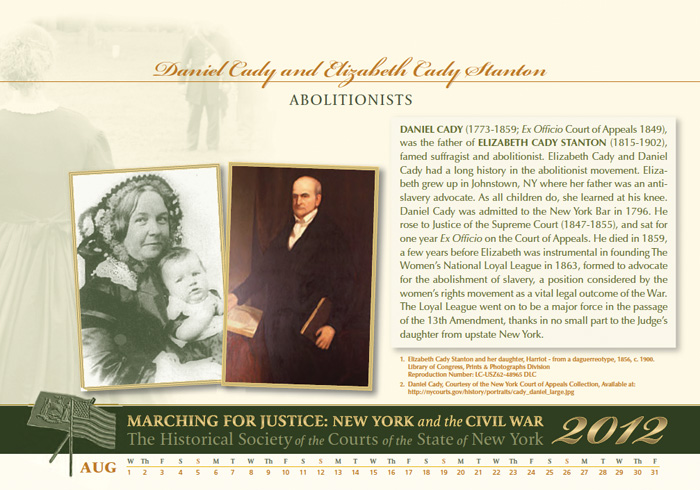
Daniel Cady and Elizabeth Cady Stanton: Abolitionists
DANIEL CADY (1773-1859; Ex Officio Court of Appeals 1849), was the father of ELIZABETH CADY STANTON (1815-1902), famed suffragist and abolitionist. Elizabeth Cady and Daniel Cady had a long history in the abolitionist movement. Elizabeth grew up in Johnstown, NY where her father was an antislavery advocate. As all children do, she learned at his knee. Daniel Cady was admitted to the New York Bar in 1796. He rose to Justice of the Supreme Court (1847-1855), and sat for one year Ex Officio on the Court of Appeals. He died in 1859, a few years before Elizabeth was instrumental in founding The Women’s National Loyal League in 1863, formed to advocate for the abolishment of slavery, a position considered by the women’s rights movement as a vital legal outcome of the War. The Loyal League went on to be a major force in the passage of the 13th Amendment, thanks in no small part to the Judge’s daughter from upstate New York.
Images:
Elizabeth Cady Stanton and her daughter, Harriot – from a daguerreotype, 1856, c. 1900. Library of Congress, Prints & Photographs Division Reproduction Number: LC-USZ62-48965 DLC
Daniel Cady, Courtesy of the New York Court of Appeals Collection, Available at: http://nycourts.gov/history/portraits/cady_daniel_large.jpg
September 2012

The New York City Draft Riots
THE NEW YORK CITY DRAFT RIOTS, July 13-16, 1863, were the ugly culmination of the nation’s discontent with new draft laws passed by Congress. The riots were the largest civil insurrection to that time apart from the Civil War itself. President Lincoln sent several regiments of militia and volunteer troops for riot control. The rioters, overwhelmingly working-class immigrant men, feared increasing competition for jobs by newly freed slaves, and deeply resented the laws which exempted from service those able to pay a $300 fee-benefiting the wealthy. Initially targeting government offices associated with the draft, the rioters quickly turned on New York’s black population and anyone who supported abolition and the War. Looting and arson were wide-spread, and thousands were injured, with at least 120 killed. By July 17th, state and federal troops were finally able to quell the protests. While the violence did not result in the amending of the conscription laws, Boss Tweed created a fund to pay the $300 fee for worthy New Yorkers who could not afford the military exemption fee. Though martial law was never invoked, the protests of New York City’s population reminded the Republicans they were not the only voice in setting Union policy.
Images:
The Riots in New York: Conflict Between the Military and the Rioters in First Avenue, The Illustrated London News, August 15, 1863. New York Public Library, Digital ID: 809571
October 2012
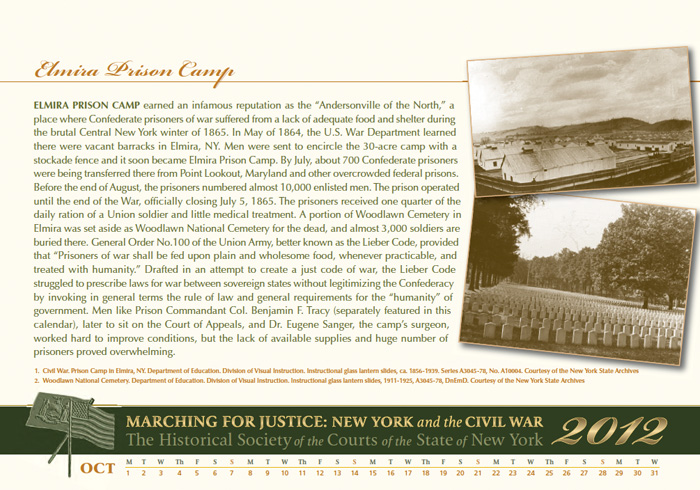
Elmira Prison Camp
ELMIRA PRISON CAMP earned an infamous reputation as the ‘Andersonville of the North,’ a place where Confederate prisoners of war suffered from a lack of adequate food and shelter during the brutal Central New York winter of 1865. In May of 1864, the U.S. War Department learned there were vacant barracks in Elmira, NY. Men were sent to encircle the 30-acre camp with a stockade fence and it soon became Elmira Prison Camp. By July, about 700 Confederate prisoners were being transferred there from Point Lookout, Maryland and other overcrowded federal prisons. Before the end of August, the prisoners numbered almost 10,000 enlisted men. The prison operated until the end of the War, officially closing July 5, 1865. The prisoners received one quarter of the daily ration of a Union soldier and little medical treatment. A portion of Woodlawn Cemetery in Elmira was set aside as Woodlawn National Cemetery for the dead, and almost 3,000 soldiers are buried there. General Order No.100 of the Union Army, better known as the Lieber Code, provided that ìPrisoners of war shall be fed upon plain and wholesome food, whenever practicable, and treated with humanity.î Drafted in an attempt to create a just code of war, the Lieber Code struggled to prescribe laws for war between sovereign states without legitimizing the Confederacy by invoking in general terms the rule of law and general requirements for the ‘humanity’ of government. Men like Prison Commandant Col. Benjamin F. Tracy (separately featured in this calendar), later to sit on the Court of Appeals, and Dr. Eugene Sanger, the camp’s surgeon, worked hard to improve conditions, but the lack of available supplies and huge number of prisoners proved overwhelming.
Images:
Civil War. Prison Camp in Elmira, NY. Department of Education. Division of Visual Instruction. Instructional glass lantern slides, ca. 1856-1939. Series A3045-78, No. A10004. Courtesy of the New York State Archives
Woodlawn National Cemetery. Department of Education. Division of Visual Instruction. Instructional glass lantern slides, 1911-1925, A3045-78, DnEmD. Courtesy of the New York State Archives
November 2012
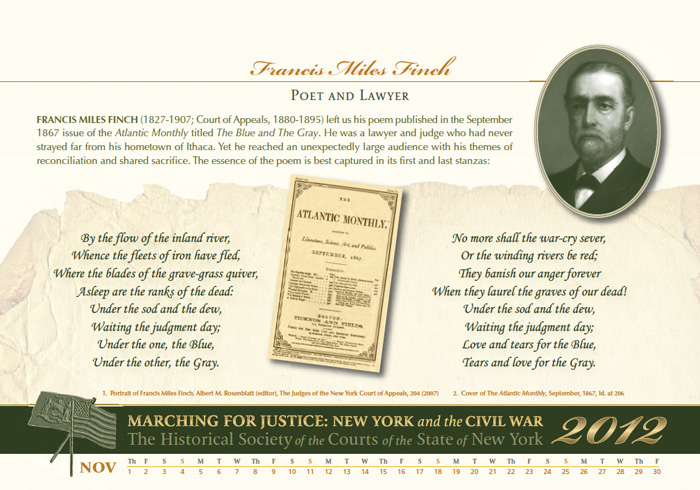
Frances Miles Finch: Poet and Lawyer
FRANCIS MILES FINCH (1827-1907; Court of Appeals, 1880-1895) left us his poem published in the September 1867 issue of the Atlantic Monthly titled The Blue and The Gray. He was a lawyer and judge who had never strayed far from his hometown of Ithaca. Yet he reached an unexpectedly large audience with his themes of reconciliation and shared sacrifice. The essence of the poem is best captured in its first and last stanzas:
By the flow of the inland river,
Whence the fleets of iron have fled,
Where the blades of the grave-grass quiver,
Asleep are the ranks of the dead:
Under the sod and the dew,
Waiting the judgment day;
Under the one, the Blue,
Under the other, the Gray.
No more shall the war-cry sever,
Or the winding rivers be red;
They banish our anger forever
When they laurel the graves of our dead!
Under the sod and the dew,
Waiting the judgment day;
Love and tears for the Blue,
Tears and love for the Gray.
Images:
Portrait of Francis Miles Finch. Albert M. Rosenblatt (editor), The Judges of the New York Court of Appeals, 204 (2007)
Cover of The Atlantic Monthly, September, 1867, Id. at 206
December 2012
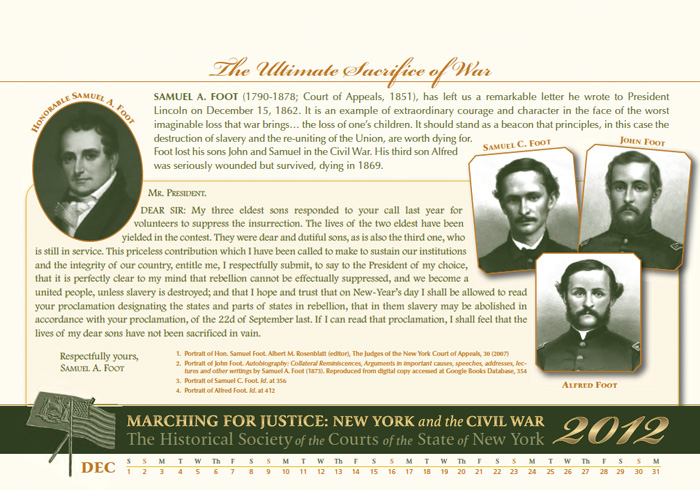
The Ultimate Sacrifice of War
SAMUEL A. FOOT (1790-1878; Court of Appeals, 1851), has left us a remarkable letter he wrote to President Lincoln on December 15, 1862. It is an example of extraordinary courage and character in the face of the worst imaginable loss that war bringsÖ the loss of one’s children. It should stand as a beacon that principles, in this case the destruction of slavery and the re-uniting of the Union, are worth dying for. Foot lost his sons John and Samuel in the Civil War. His third son Alfred was seriously wounded but survived, dying in 1869.
Mr. President.
DEAR SIR: My three eldest sons responded to your call last year for volunteers to suppress the insurrection. the lives of the two eldest have been yielded in the contest. they were dear and dutiful sons, as is also the third one, who is still in service. this priceless contribution which i have been called to make to sustain our institutions and the integrity of our country, entitle me, i respectfully submit, to say to the President of my choice, that it is perfectly clear to my mind that rebellion cannot be effectually suppressed, and we become a united people, unless slavery is destroyed; and that i hope and trust that on New-Year’s day i shall be allowed to read your proclamation designating the states and parts of states in rebellion, that in them slavery may be abolished in accordance with your proclamation, of the 22d of september last. if i can read that proclamation, i shall feel that the lives of my dear sons have not been sacrificed in vain.
Respectfully Yours,
SAMUEL A. FOOT
Images:
Portrait of Hon. Samuel Foot. Albert M. Rosenblatt (editor), The Judges of the New York Court of Appeals, 30 (2007)
Portrait of John Foot. Autobiography: Collateral Reminiscences, Arguments in important causes, speeches, addresses, lectures and other writings by Samuel A. Foot (1873). Reproduced from digital copy accessed at Google Books Database, 354
Portrait of Samuel C. Foot. Id. at 356
Portrait of Alfred Foot. Id. at 412


